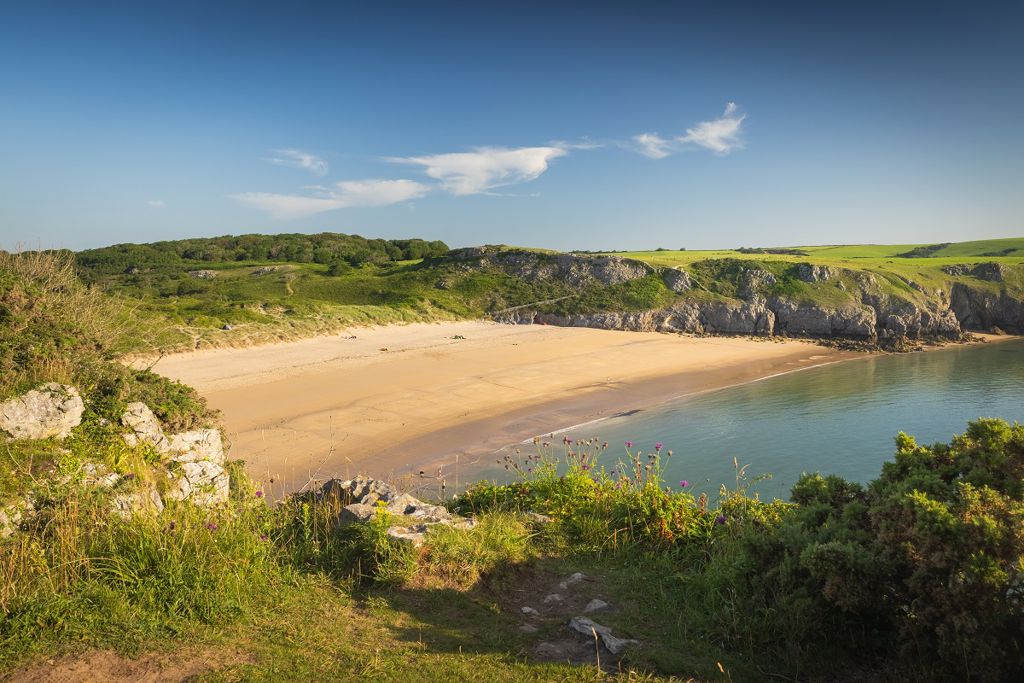Afan Forest Park – Visitor Centre, near Port Talbot
Main starting point for mountain bike and walking...

Stackpole National Nature Reserve is in south Pembrokeshire.
The National Trust owns and manages the reserve in partnership with Natural Resources Wales.
The National Trust provides the car parks and visitor facilities.
Plan your visit in advance by checking the latest information on the National Trust website.
Stackpole National Nature Reserve's diverse landscape includes the shallow freshwater Bosherton lakes, woodlands, dunes, limestone cliffs and beaches.
The cliffs demonstrate the geology of Stackpole.
They are topped by a limestone plateau which was lifted from the sea-bed around 50 million years ago.
Look closely and you will see a band of lighter rock, the compressed remnant of an ancient beach, formed when the sea level was much higher.
Two of Pembrokeshire’s finest beaches – the sheltered havens of Broadhaven and Barafundle Bay – lie within the reserve.
Stackpole is an area of limestone grassland and ancient dune grassland which was created during the fifth and sixth centuries.
It is bordered by scrub and woodland and, in spring, the area is alive with bird song and rich with flowers and butterflies.
Bosherston Lakes were created in valleys in the limestone in the 18th and 19th centuries by the Campbells of Cawdor, owners of the Stackpole Estate until 1976.
The calm surface of the lakes is adorned with white water lilies in summer, together with beds of bright green stonewort: these are a speciality of the lime-rich spring-fed crystal clear waters here.
Stackpole is a stronghold for several species, including one of Britain’s largest populations of the rare greater horseshoes bats.
The lakes are abundant with wildlife especially otters, water birds and dragonflies.
The limestone cliffs, dunes and maritime grassland support many kinds of special plants and animals, including diminutive soil and rock lichens, numerous flowering plants, scarce insects and breeding populations of chough and colonial seabirds.
The landscape and wildlife varies depending on which time of year you visit – here’s what to look out for.
As the days lengthen, the woodlands come alive with early purple orchids, primroses and pungent wild garlic.
In the grasslands and sand dunes, there is a colourful display of spring squill and cowslips. Thrift comes into flower on the cliffs and clumps of marsh marigold create splashes of yellow on the edge of the lakes.
The cliffs are home to many seabirds such as choughs, guillemots, razorbills and even a few puffins.
You may also spot bats in the woodlands at twilight or feeding on insects over the lakes.
The woodlands are home to the silver washed fritillary butterfly while other butterflies such as the dark green fritillary, common blue and brown argus may be spotted on the grasslands and sand dunes.
Summer brings a varied display of wild flowers to the reserve. Bee orchids, common spotted orchids and wild thyme appear in the grasslands and on the sand dunes and white water lilies grace the lakes. Thrift is still in flower on the cliffs and is joined by golden samphire and wild thyme.
Skylarks can be heard singing overhead and reed warblers can be spotted in the lakes.
Just as in spring, the cliffs are alive with seabirds from choughs to guillemots and razorbills to puffins.
As the weather turns cooler, the grassland is dotted with colourful waxcap fungi and the spindle trees are covered in their distinctive pink fruit.
There’s plenty to see at Stackpole in the winter.
Surrounded by the stark colours of dogwood at the water’s edge, the lakes are a good place to spot a wide range of wintering and other birds including:
Stackpole is a National Nature Reserve.
National Nature Reserves are places with some of the very finest examples of wildlife habitats and geological features.
There are over 70 National Nature Reserves in Wales.